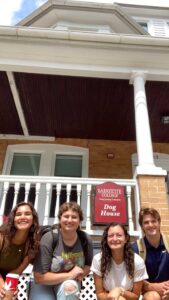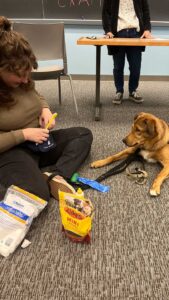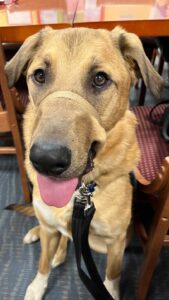Learn More
- If you’re a Lafayette student interested in learning more or applying to live at the Dog House, or learning more about other student residences, contact Residence Life at 610-330-5335 or reslife@lafayette.edu for more information.
Residents of Lafayette’s Dog House have unique opportunity to help train service dogs and make fur-ever friends
By Stella Katsipoutis-Varkanis

A few of the 2022-23 Dog House student residents (from left to right): Mia Farmer ’23, Caroline Schaeffer ’23, Julia Banks ’23, and Avery Warmack ’23
At Lafayette, the phrase “being in the Dog House” carries a very different meaning from what you’d typically expect.
A charming brick Victorian building near the main campus, the Dog House is one of the College’s special interest houses, where student residents who share a love of dogs have the opportunity to not only make friends, build connections across campus, and participate in exciting activities that center on their interests, but also grow a very specific and unique skill set that serves the greater community: training pups to become service dogs.
For the last six years, with the guidance of their adviser, Associate Professor of English Bianca Falbo (who also is a certified dog trainer), Dog House residents have partnered with the nonprofit organization Canine Partners for Life (CPL) to provide basic training to 6- to 10-month-old puppies that could potentially go on to become service dogs, or home and residential companion dogs, that assist individuals with a wide range of physical and cognitive disabilities.
“The residents’ job is to refine the basic skills the dogs learned as puppies, like ‘sit’ and ‘stay,’ and then teach them more advanced cues, like using their nose to push a button that will open a door, holding and carrying an item in their mouth, staying for extended periods of time, and other things that would help their future owners,” says Caroline Schaeffer ’23, former Dog House student resident and CPL volunteer, who earned a Bachelor of Science in biochemistry.
When they first move into the Dog House, students are required to attend two intensive training sessions at CPL’s headquarters in Cochranville, Pa., where they are taught basic dog-training techniques, such as using clickers and gentle leaders, teaching elementary cues, and administering treats to reinforce positive behavior.

Julia Banks ’23 working with service-dog-in-training Kramer at a grocery store
“Students are given a manual on how CPL approaches training,” Schaeffer says. “They use cues as opposed to commands, letting the dogs know you’re working alongside them rather than telling them they’re working for you. There is no punishment when a dog isn’t doing something you want—just positive clicker training and using food as a reward when the dog follows a cue. I think they’re one of the best service dog training organizations, because they prioritize the dog.”
Back at the house, which is split into two separate living spaces, two dogs are placed in the care of the student residents—one dog on each side of the house—at the beginning of the academic year for at least eight months, depending on how long it takes the dogs to learn what CPL needs them to learn at that point in the overall training program. The students, who also are evenly split between the house’s two sides, alternate spending time with their assigned dog throughout the day.
“Each student spends about four hours with their dog daily,” Schaeffer says. “But it’s not like you’re training them for all four hours. The dogs get time to just be dogs—hang out, play, nap, go on walks, spend time in the backyard, and eat. And at the end of the day, you usually work on the skill you’re focusing on at that time. The students also have to go to classes, and they coordinate and schedule their time with the dogs accordingly. They have a calendar of where the dog needs to be, who the dog is with, and when the students trade off; you have to be very organized. You can still have time to yourself to hang out, study, and do homework; but when you do, the dog is usually with you, either sitting with you or playing in the next room.”

Caroline Schaeffer ’23 working with service-dog-in training Wiss Fiss in a Lafayette classroom
For this reason, Schaeffer says, it’s imperative that any student interested in living in the Dog House—which is open to sophomore, junior, and senior applicants—enjoys working as a member of a larger team.
“What the Dog House is looking for in students who apply to live there are people who are cooperative and work well with others,” she says. “You need to be open to constructive feedback, communicative about what you have going on, and willing to flex and adjust your schedule in order to meet the needs of the dog and your housemates. The residents all have each other’s backs.”
Schaeffer also explains that Lafayette’s campus—with its open green spaces and walkable layout—offers the perfect setting for the training sessions that take place outside of the Dog House.
“Campus is only a block away from the house—which is great because, while you do a lot of training in the house, you want the dogs to be able to do what you teach them in the hustle and bustle of everyday life. As long as they have their vest on, you can take them into different buildings where it’s a bit more hectic, and it’s good for the dogs to experience that. It’s just kindly asked that no one tries to pet or distract the dogs with noises when they’re wearing their service vests, since the vests indicate they’re actively working. A good rule of thumb for community members is to ask if they can pet the dog—if the dogs aren’t wearing their vest, Dog House students almost always say yes.”

Wiss Fiss, one of the service-dogs-in-training at Lafayette’s Dog House for the 2022-23 academic year
After their time at Lafayette, the dogs move on to their next phase of training at CPL headquarters, where they learn how to do more advanced tasks (like helping their handler pay for something at a store, or alerting someone when their handler isn’t feeling well) and can potentially be selected for specific service dog roles. While not all dogs graduate from the overall CPL program and go on to work as service dogs (those that don’t are placed in loving adoptive homes), those that do graduate are paired with someone in need.
“When the dogs graduate from their program, CPL gives the dogs for free to people who are disabled,” Schaeffer says, “which is really nice. It’s another thing I love about CPL.”
And the dogs aren’t the only ones that benefit from their time in the Dog House—some student residents of the past loved the experience so much that they decided to work as professional dog trainers after graduating from Lafayette. Mike Astor ’17, one of the founding members of the Dog House, for example, recently graduated from Cornell University’s College of Veterinary Medicine and is now a practicing veterinarian at Vernon Woods Animal Hospital in Georgia. Erica Luing ’20, who was a math major and Dog House resident, now works as a puppy class trainer at Susquehanna Service Dogs. Prior to that position, she worked as a service dog trainer at Puppy Jake Foundation in Iowa.
The students’ learning experiences also go beyond the building of technical dog-training skills, Falbo explains. “It’s not enough to love dogs, or even love dog training and learning about dog behavior,” she says. “It’s also that the dogs’ needs come first. That’s not negotiable, and students tell me how much, as a result, they have also learned about themselves—about their capacities for patience and empathy, for example. And not just for dogs, but also fellow humans. Navigating the world with a service dog can push you to think about issues of equity and inclusion in new ways.”

Kramer, one of the service-dogs-in-training at Lafayette’s Dog House for the 2022-23 academic year
If you ask Schaeffer what she treasured most about living in the Dog House, she’ll tell you it was the time she got to spend with her furry friends, the lifelong bonds she created with her human friends, and the priceless life lessons they each taught her—all while working for the greater good.
“I just love dogs, and I am my best person when I’m around them,” Schaeffer says. “You definitely have challenging days—the dogs are young and sometimes push your boundaries. But to watch them get something you’re trying to teach them is the best feeling in the world. You create such a strong relationship with them because you spend so much time together, and it was hard to see them go when they were ready to move on from Lafayette. I also made my best friends by living in the Dog House—I found my people there. I learned a lot in my classes, but there I learned how to be a better person.”